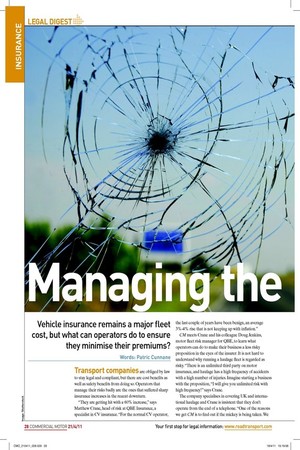ana9in9 the
Page 21

Page 22

If you've noticed an error in this article please click here to report it so we can fix it.
Vehicle insurance remains a major fleet cost, but what can operators do to ensure they minimise their premiums?
Words: Patric Cunnane Transport companies are obliged by law to stay legal and compliant, but there are cost beneits as well as safety beneits from doing so. Operators that manage their risks badly are the ones that suffered sharp insurance increases in the recent downturn.
“They are getting hit with a 60% increase,” says Matthew Crane, head of risk at QBE Insurance, a specialist in CV insurance. “For the normal CV operator, the last couple of years have been benign, an average 3%-4% rise that is not keeping up with inlation.” CM meets Crane and his colleague Doug Jenkins, motor leet risk manager for QBE, to learn what operators can do to make their business a less risky proposition in the eyes of the insurer. It is not hard to understand why running a haulage leet is regarded as risky. “There is an unlimited third party on motor insurance, and haulage has a high frequency of accidents with a high number of injuries. Imagine starting a business with the proposition, “I will give you unlimited risk with high frequency!” says Crane.
The company specialises in covering UK and international haulage and Crane is insistent that they don’t operate from the end of a telephone. “One of the reasons we get CM is to ind out if the mickey is being taken. We visit a lot of our clients to see how they operate. That way you get a more honest feeling for the risk,” says Crane.
So what can operators do to manage their risk better and either lower their premium or keep it at a reasonable level?
Crane offers some pointers: ● Carry out a risk assessment.
● Focus on employees’ risk avoidance skills – they are an asset, not a commodity.
● Risk transfer – can you take on some of the risk yourself and cut your excess?
● Larger businesses might consider a self-insured programme where they pay the frst £500,000.
● Often hauliers pay commission to a broker, but are they really getting a service from them? He points out that QBE offers operators an incentive by keeping the same price for the next year’s coverage if they cut their risk.
However, one of the variables that makes pricing dif�cult is that hauliers don’t always know if they will have the same contracts next year. “It helps for operators to have a long-term relationship with their provider. After all, we have to look forward as well,” says Crane.
It’s up to operators to take the initiative. “They can inluence how much they pay,” says Crane. “The losses of the few are paid by the premiums of the many, so risk assessment has got to be targeted. It’s not just about doing the odd training course, on how you load your vehicle or driver training – it’s about your attitude. The attitude of the sole trader should be no distance away from the conglomerate.” One device that may give an indication of risk is an operator’s compliance risk score, but Jenkins says this is rarely offered. “They are very reluctant to tell me,” he says. He adds that the intelligent use of telematic devices can be another aid to risk reduction. ■













































